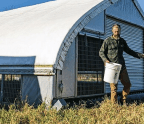
When most people think about planting a garden, it’s probably fair to say they think of putting in spring and summer gardens. After all, fresh, bright-green foliage and colorful flowers after dreary, gray days of winter are a welcome sight. But this year, consider helping migratory monarch butterflies by showing some love to the autumnal garden.
Fall is a critical time for the butterfly known for its striking orange and black wing patterns. It’s when the monarch butterfly begins its migration south. The migratory monarch butterfly can be broadly split into two populations: the ones west of the Rocky Mountains and the ones east of it. (For more on the western migratory monarch population, check out “Watching Out for the Western Monarchs” on Page 36.)
The eastern monarchs make up the majority of the North American monarch population. Beginning in mid-August and ending in early November, they travel from the northern end of their summer breeding range — from the Canadian provinces of Alberta to Nova Scotia and from the U.S. Upper Midwest to the northeastern states —




